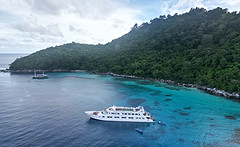
LIVEABOARD: EPOXY WORK
June 25-29, 2022

Divers deployed concrete boxes onto the sea floor, allowing for the attachment of viable coral heads with epoxy. Volunteers worked in pairs to ensure proper and effective techniques were used in order to increase the chance of coral survival.

OUR TEAM







ARTIFICIAL REEFS

Divers deployed concrete boxes onto the sea floor, allowing for the attachment of viable coral heads with epoxy. Volunteers worked with members of the DMCR to ensure proper and effective techniques were used in order to increase the chance of coral survival.



THE PROCESS




1. EDUCATION
Corals are very sensitive animals and need to be properly planted in order to ensure survival. Hence, leaders from the Department of Marine and Coastal Resources joined forces with Care for Coral team members to provide comprehensive education about the proper ways to handle and restore corals with epoxy. After completion of this training course, volunteers recieved their coral restoration specilaist certifcations.
2. MOLDING EPOXY
DMCR members taught our volunteers how to create the perfect epoxy mold, combining resin and epoxy together in order to create a suitable mixture that will cure underwater. Once the epoxy hardens, it will attach and secure the corals to our concrete bases. Our students were taught to twist the two clay-like adhesives together until the colors blended.








3. SCAVENGING FOR CORAL FRAGMENTS
DMCR members taught our volunteers how to accurately detect coral fragments that were still viable for planting. Fragments needed to be an appropriate size and have living coral tissue. Once securely attached to the concrete structure, the corals will be able to form larger colonies.
4. UNDERWATER MIXING
In order to avoid the dissipation of the adhesive chemicals while creating the epoxy and resin clay mixture, trash cans were used to create an air bubble beneath the water's surface. Divers combined the epoxy-resin mixture within the dry area, relying on their sense of touch to determine if both compounds were thoroughly conglomerated.








5. ATTACHMENT!
Finally, divers worked in groups of two, supervised by a DMCR member, to securely attach the viable coral fragments onto the concrete structures. The first step was to gently brush away any sand on the concrete base. Second, a dab of epoxy is rolled into a ball and flattened out onto the base. Next, divers positioned the coral fragment at an angle that maximizes the surface of living tissue reaching sunlight. Lastly, epoxy is used to secure the fragments to the base. Since calcium bicarbonate from the skeletons of stony corals, concrete is very biologically friendly to coral growth. Concrete is also cost-effective, and its weight helps to ensure that these nurseries will not be knocked down.

DIVE FOR DEBRIS










